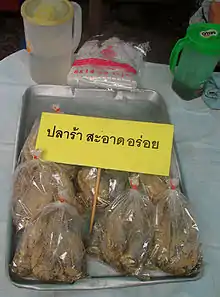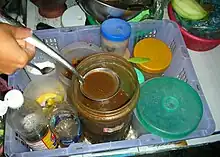Pla ra
Pla ra (Thai: ปลาร้า, pronounced [plāː ráː]), similar to padaek in Laos, is a traditional Thai[1] seasoning produced by fermenting fish with rice bran or roasted rice flour and salt fermented in a closed container for at least six months.[2][3] Fermented fish seasoning are commonly found in Cambodian, Lao, Mon, Thai and Vietnamese cuisine.[1] Pla ra has a very strong smell, which is considered unpleasant by some people. Its flavors are salty and sour, depending on the amount of salt put in and lactic acid resulting from fermentation process.



History
Pla ra was a common food in the Ayutthaya Kingdom. The French diplomat Simon de la Loubère, who visited Siam during the mid-Ayutthaya period, wrote about pla ra:
As we eat less in Summer than in Winter, they eat less than we, by reason of the continual Summer in which they live; their common Food is Rice and Fish. The Sea affords them very delicate small Oysters, very excellent small Turtles, Lobsters of all sizes, and admirable Fish, the sorts of which are unknown to us. Their River is also very plentiful of Fish, and principally very good and curious Eels: But they make little esteem of fresh Fish.
Amongst the Fresh-water Fish, they have some little ones of two sorts,* which do here deserve to be mention'd. They call them Pla out, and Pla cadi, that is to say the Fish out, and the Fish cadi. To free me from all doubts, some have assur'd me, that after they have salted them together, as the Siameses us'd to do, if they leave them in an earthen Pot in their Pickle, where they soon corrupt, by reason they salt ill at Siam, then, that is to say when they are corrupted, and as it were in a very liquid Paste, they do exactly follow the flux and reflux of the Sea, growing higher and lower in the Pitcher as the Sea ebbs or flows. Mr. Vincent gave me a Pot thereof at his arrival in France, and assur'd me that this Experiment was true, and that he had seen it; but I cannot add my Testimony thereunto, by reason I was too late advertised thereof at Siam, to have an occasion of ascertaining it by my own Eyes; and that the Pot which Mr. Vincent gave me, and which I brought to Paris, perform'd this Effect no more: perhaps because the Fish were too much corrupted, or that their virtue of imitating the flux and reflux of the Sea continues only a certain time.
The Siameses find much difficulty to make good Salt,* by reason that Meats do hardly take Salt in excessive hot Countries; but they love Fish ill season'd and dry better than fresh, even stinking Fish displeaseth them not no more than rotten Eggs, Locusts, Rats, Lizards, and most Insects: Nature doubtless framing their Appetite to things, the Digestion whereof is more easie to them. And it may be that all these things have not such an ill taste as we imagine.
A Siamese makes a very good Meal with a pound of Rice a day,* which amounts not to more than a Farthing; and with a little dry or salt Fish, which costs not more. The Arak or Rice Brandy is not worth above two Sols for that quantity, which amounts to a Parisian Pint; after which it is no wonder if the Siameses are not in any great care about their Subsistence, and if in the Evening there is heard nothing but Singing in their Houses.
Their Sauces are plain, a little Water with some Spices, Garlic, Chibols,* or some sweet Herb, as Baulm. They do very much esteem a liquid Sauce, like Mustard, which is only Cray-Fish corrupted, because they are ill salted; they call it Capi. They gave Mr. Ceberet some Pots thereof, which had no bad Smell.[4][5][6][7]
explained that the main source of food was rice and fish. Siamese people did not like to eat fresh fish. Fermented fish was popular as much as spicy Thai dip or Nam phrik. When he returned to France, he brought some pla ra with him.[8][1][9][10]
Classification
Pla ra is classified by its main ingredients. Pla ra that is fermented with roasted rice powder will become yellow with a soft texture and distinctive smell. Mostly used as a paste, this type of pla ra is usually produced in central Thailand. This type of pla ra usually has striped snakehead fish or catfish as a main ingredient.[11][12] The other type is pla ra fermented with rice bran. The product's color is clear black with a stronger smell. The fish is softer and smaller. It is mostly found in northeastern Thailand as an ingredient, or as a raw food.[3]
Pla ra which uses fresh fish is called pla ra sot. Its flavors are salty with a little bit sour from lactic acid. Pla ra lom uses dead fish with has an autolysis reaction until it has an unpleasant smell, or uses fish which is soaked in water for 12–24 hours until it is softer.[3]
Process
There are differing methods to produce pla ra. One method holds that there are two phases for making pla ra. The first phase is to ferment fish with salt until it is softer, and the next phase is to ferment it with rice bran or roasted rice powder for its scent and flavor. A second approach is to ferment the fish with salt and coarsely pounded, toasted, raw glutinous rice for at least six months.[1]
The process starts with cutting the fish into small pieces and fermenting it with salt. After 24 hours, the fish is arranged in a container (mostly a pot) until it is tightly packed and filled with salt water afterwards. The container is sealed for three months. After three months, a first stage pla ra will be mixed with rice bran or roasted rice powder. Then, it will be rearranged in the container and sealed for two months or more.[3]
In 2018, the Thai Ministry of Agriculture published regulations to ensure the quality and hygiene of commercially-made pla ra.[13]
Dishes
Pla ra is usually eaten raw or as a chilli fish sauce (nam phrik pla ra). This dish is made of roasted green pepper, garlic, shallots, and boiled fish meat. All of these ingredients are ground together. Then boiled fermented fish liquid, fish sauce, and lime juice are added to the mixture. It is used as a side dish for dipping vegetables or eaten with rice.[2] Pla ra can also be processed into a powder by baking it with some spices until it is dry and the grinding it all together.[14] Nam phrik pla ra and Pla ra song krueng or lon pla ra[15][16] are common in Thailand's Central Region.
Nutrition
| Composition | Amount |
|---|---|
| Protein | 16.08–18.94% |
| Moisture | 28.90–71.48% |
| Fat | 0.71–3.20% |
| Salt | 5.23–9.14% |
| Calcium | 1505.06 mg % |
| Phosphorus | 661.75 mg % |
| Vitamin B12 | 2.175±1.78 mg % |
| pH | 4.5–6.2 |
| Lactic acid | 0.3–1.90 |
| Microorganisms | 2.2x106—8.8x107 |
Many species of bacteria have been found in pla ra:
- Assorted species of Pediococcus, primarily P. halophilus
- Assorted species of Staphylococcus, primarily S. epidermidis
- Assorted species of Micrococcus
- Bacillus subtilis and B. licheniformis
- Other, non-spore-forming gram-positive bacteria
- Other gram-negative bacteria
P. halophilus is most prevalent when pla ra is fermented for three to five months. A study found that 90% of samples from markets contain this species of bacterium, so it has been concluded that it has an important role in the fermenting process, especially for pla ra's taste and aroma. Other Pediococcus species also have a role in the taste and aroma, but not as much as P. halophilus. Species of Staphylococcus, Micrococcus, and Bacillus act in protein degradation.[3]
Health issue
When using pla ra as an ingredient for uncooked food, it is easily contaminated. An example is nam phrik (chilli fish sauce) which uses pla ra as an ingredient. Nam phrik is not cooked and is often kept for one or two meals. After a while, it will contain pathogens and have a high microorganism count. In some cases, nam phrik had both E. coli and S. aureus present, but no pathogenic organisms. The reason is the acid from tamarind made the pH less than 4.6, which prevents the growth of most pathogens. Pla ra before reheating is contaminated with S. aureus but the coliform is low and it is destroyed by cooking.[2]
Other uses
In a recent move by the police and redevelopment workers to evict vendors from a market in the Khlong Toei District in Bangkok, the local vendors barricaded themselves in the market. During the scuffles that ensued, the traders made "stink bombs" with thin plastic bags filled with pla ra and hurled them at policemen.[18] On 1 February 2010 bags of excrement and pla ra were thrown at Thai Prime Minister Abhisit Vejjajiva's house.
See also
- Budu – Fish sauce originating from east coast of Peninsular Malaysia
- Burong isda – Filipino dish of rice and pickled fish
- Conpoy – Cantonese dried scallop
- Fish sauce – Condiment made from fish
- List of fish sauces
- Narezushi – Japanese dish of vinegared rice and usually seafood
- Padaek – Traditional Lao condiment made from pickled or fermented fish that has been cured
- Prahok – Cambodian salted and fermented fish paste
- Saeu-jeot – Salted and fermented small shrimp in Korean cuisine
- Shrimp paste – Fermented condiment
- Kaeng tai pla – Southern Thai curry, made with a salty sauce made from fermented fish entrails
References
- Sukphisit, Suthon (9 June 2019). "An Acquired Taste". Bangkok Post. No. B. Magazine. Retrieved 9 June 2019.
- Phithakpol, Bulan (1985). Phase I: Food Handling at Village and Household Levels in Thailand. Bangkok: The Institute of Food Research and Product Development, Kasetsart University.
- Boon-Long, Narudom (1985). Development of Traditional Fermented Fish Product for Small Industries: Precessed development of Pla-ra from salt water fish. Bangkok: Faculty of Agro-ind., Kasetsart University.
- de La Loubère, Simon (1693). A New Historical Relation of the Kingdom of Siam CHAP. IV. Concerning the Table of the Siameses. Translated by A.P.
- de La Loubère, Simon (1691). Du Royaume de Siam par Monsieur de La Loubere envoyé extraordinaire du Roy auprès du roy de Siam en 1687. & 1688: Volume 1 (in French). Vol. 1. Chez la Vve de Jean-Baptiste Coignard et Jean BaptisteCoignard. p. 154.
- "ขนมปัง-ปลาร้า ของกินพระราชทานสมัยกรุงศรีอยุธยา ทูตฝรั่งรีวิวไว้ว่าอย่างไร?" (in Thai). Retrieved 17 February 2021.
- "อาหารเมืองไทยตั้งแต่กรุงศรีฯ-กรุงเทพฯ จากมุมมองของต่างชาติ" (in Thai). Retrieved 17 February 2021.
- "The Evolution of Cultural Landscape and Built Environment Through Thai Food and Way of Living: The Case Study of Central Region of Thailand" (PDF). Dusit Thani College Journal. Retrieved 16 February 2021.
- สถาบันอยุธยาศึกษา มหาวิทยาลัยราชภัฏพระนครศรีอยุธยา (4 October 2019), ภูมิปัญญาท้องถิ่น การทำปลาร้าหมักสูตรโบราณอยุธยา (in Thai), archived from the original on 19 December 2021, retrieved 17 February 2021
- Plaa raa (fermented fish) and nam plaa (salty fish sauce), retrieved 17 February 2021
- วิธีทำปลาร้า วิธีหมักปลาร้า ปลาร้าสูตรทำขาย ปลาร้าสูตรโบราณภาคกลาง ปลาร้าปลานิล (th:Pla nil, en:Nile tilapia) (in Thai), archived from the original on 19 December 2021, retrieved 17 February 2021
- "วิธีทำปลาร้า ปลาร้าข้าวคั่ว" (in Thai). Retrieved 17 February 2021.
- "Agriculture Ministry sets quality standard for 'pla ra' fermented fish". Thai PBS. 18 April 2018. Archived from the original on 19 April 2018. Retrieved 19 April 2018.
- ชมภูเพชร, พงษ์พันธุ์ (2003). รวยด้วยปลา. Bangkok, Thailand: Matichon.
- "Pla ra song Krueng recipe". 23 May 2018. Retrieved 17 February 2021.
- "Lon Pla Ra(Simmered preserved fish)". Thaifolk.com. Retrieved 9 June 2019.
- Boon-Long, Phithakpol (1993). Lee, Cherl-Ho; Steinkraus, Keith H.; Reilly, P. J. Alan (eds.). Fish Fermentation Technology. Seoul, Korea: United Nation University Press.
- "Stink bombs deployed in market riot". Bangkok Post. 5 June 2009. Retrieved 9 June 2019.
